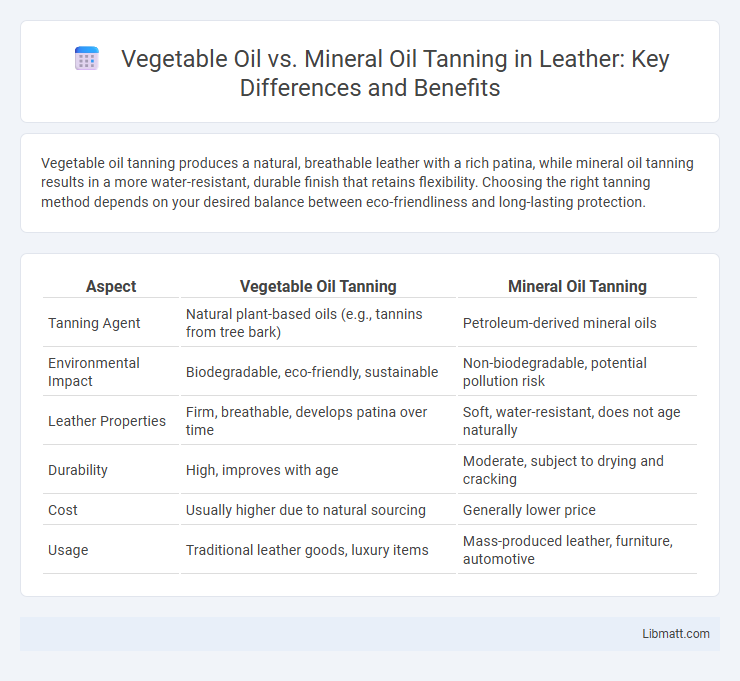Vegetable oil tanning produces a natural, breathable leather with a rich patina, while mineral oil tanning results in a more water-resistant, durable finish that retains flexibility. Choosing the right tanning method depends on your desired balance between eco-friendliness and long-lasting protection.
Table of Comparison
| Aspect | Vegetable Oil Tanning | Mineral Oil Tanning |
|---|---|---|
| Tanning Agent | Natural plant-based oils (e.g., tannins from tree bark) | Petroleum-derived mineral oils |
| Environmental Impact | Biodegradable, eco-friendly, sustainable | Non-biodegradable, potential pollution risk |
| Leather Properties | Firm, breathable, develops patina over time | Soft, water-resistant, does not age naturally |
| Durability | High, improves with age | Moderate, subject to drying and cracking |
| Cost | Usually higher due to natural sourcing | Generally lower price |
| Usage | Traditional leather goods, luxury items | Mass-produced leather, furniture, automotive |
Introduction to Vegetable Oil and Mineral Oil Tanning
Vegetable oil tanning uses natural oils extracted from plants to treat and preserve leather, enhancing its flexibility and eco-friendliness. Mineral oil tanning relies on petroleum-based oils that provide strong water resistance and durability, often suitable for industrial applications. Your choice between vegetable and mineral oil tanning affects the leather's environmental impact and performance characteristics.
Chemical Composition: Vegetable vs Mineral Oils
Vegetable oils used in tanning consist primarily of triglycerides with unsaturated fatty acids, promoting better skin absorption and natural flexibility, while mineral oils are hydrocarbons derived from petroleum, lacking reactive functional groups. The unsaturated bonds in vegetable oils enable oxidative cross-linking during the tanning process, enhancing leather durability and softness. Mineral oils, being chemically inert, act mainly as lubricants without contributing to the structural transformation of rawhide.
Tanning Process Overview: How Each Oil Works
Vegetable oil tanning involves natural oils derived from plants, penetrating the hide to nourish and soften the leather by enhancing its fiber flexibility through emollient absorption. Mineral oil tanning uses petroleum-based oils that create a water-resistant barrier on the leather surface, primarily preventing moisture absorption while maintaining surface suppleness. Both methods alter the collagen fibers differently; vegetable oils improve breathability and aging quality, whereas mineral oils emphasize durability and immediate protective properties.
Environmental Impact: Sustainability and Ecology
Vegetable oil tanning utilizes natural, renewable resources such as soybean, coconut, or castor oils, resulting in a lower carbon footprint and reduced toxic chemical emissions compared to mineral oil tanning. Mineral oil tanning relies on petroleum-based products, which contribute to environmental pollution, resource depletion, and non-biodegradable waste accumulation. Sustainable vegetable oil tanning supports circular economy principles by promoting biodegradability, reducing ecological toxicity, and enhancing soil and water health through organic waste recovery.
Leather Quality: Texture, Durability, and Finish
Vegetable oil tanning enhances leather quality by producing a firm yet supple texture with a natural, matte finish that improves with age. Mineral oil tanning typically results in softer leather with a smoother, glossier surface but may compromise durability over time. The choice impacts the leather's resistance to cracking and overall longevity, favoring vegetable oil for robust, long-lasting leather goods.
Health and Safety Considerations
Vegetable oil tanning uses natural, plant-based oils such as linseed or soybean oil, which are generally non-toxic and biodegradable, making them safer for your skin and the environment. Mineral oil tanning involves petroleum-based products that may contain impurities and pose inhalation or skin irritation risks, especially with prolonged exposure. For health and safety, choosing vegetable oil tanning reduces exposure to harmful chemicals, promoting safer handling and a lower ecological footprint.
Cost and Market Availability
Vegetable oil tanning generally offers a lower cost due to the renewable nature of plant-based oils like soybean or linseed, which are widely available in global agricultural markets. Mineral oil tanning involves petroleum-derived products, often resulting in higher and more volatile costs tied to the oil industry's supply chain and pricing fluctuations. Market availability for vegetable oil tanning is expanding as sustainability demands rise, while mineral oil tanning remains prevalent in established industrial leather sectors with consistent but environmentally scrutinized supply.
Applications and End-Use Differences
Vegetable oil tanning primarily suits leather products requiring natural breathability and flexibility, such as gloves, footwear, and upholstery, offering a softer, more organic finish. Mineral oil tanning imparts greater water resistance and durability, making it ideal for industrial goods, machinery belts, and items exposed to harsh environments. Your choice should align with the intended leather application's need for either natural texture and comfort or enhanced protection and longevity.
Industry Preferences and Trends
The tanning industry increasingly favors vegetable oil tanning due to its sustainability, biodegradability, and ability to enhance leather softness and durability naturally. Mineral oil tanning remains popular in specific applications for its cost-effectiveness and consistent moisture resistance but faces declining demand amid growing environmental concerns. Market trends indicate a shift towards plant-based tanning agents, driven by consumer preference for eco-friendly products and stricter regulatory standards on chemical usage.
Choosing the Right Tanning Method
Choosing the right tanning method depends on the desired finish, durability, and environmental impact. Vegetable oil tanning offers a more natural, eco-friendly option that enhances leather's breathability and aging process, while mineral oil tanning provides quick absorption and water resistance but may retain synthetic residues. Your choice should balance sustainability with the performance needs of the leather product.
Vegetable oil vs mineral oil tanning Infographic

 libmatt.com
libmatt.com